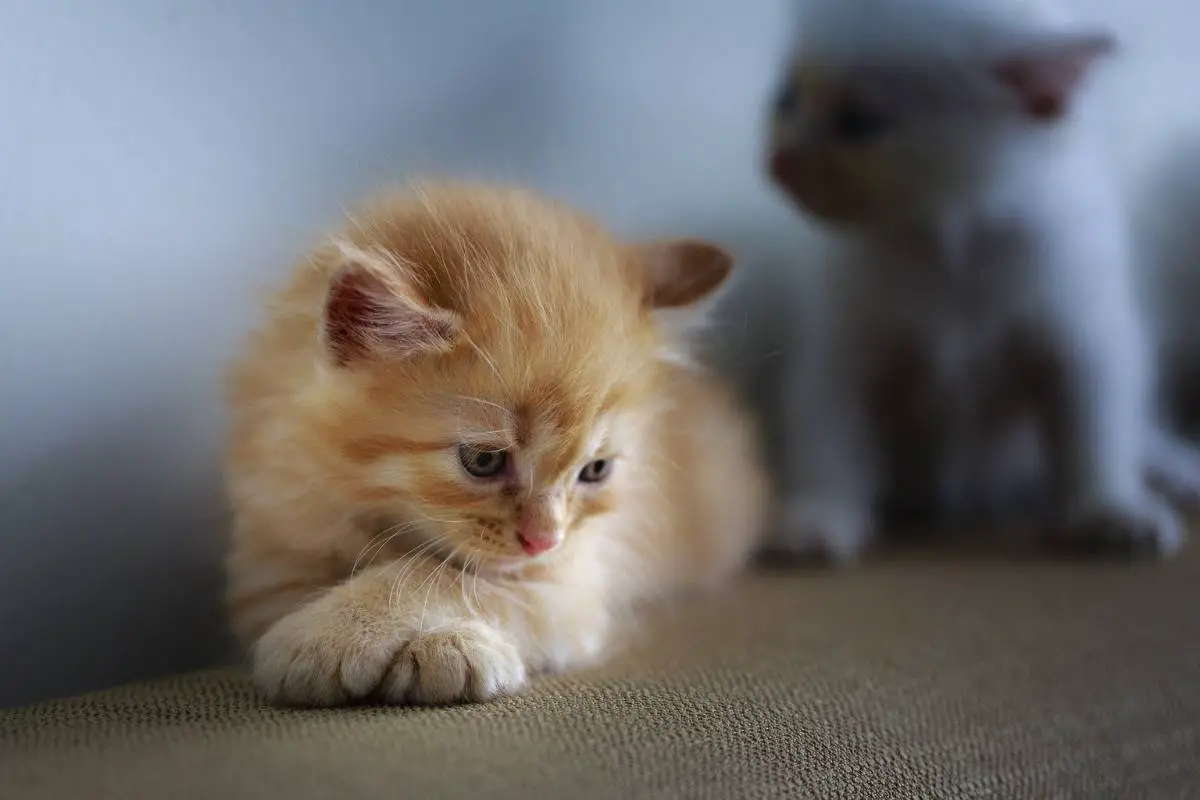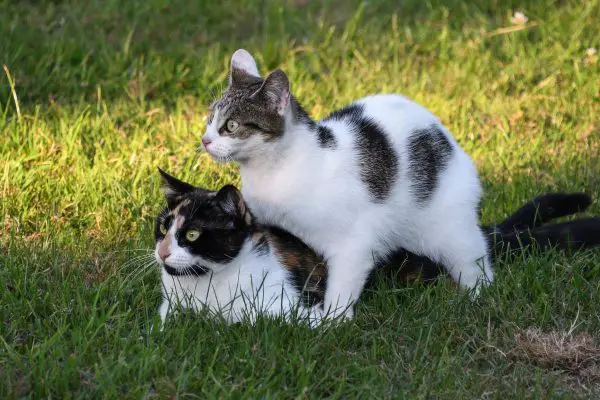Getting a new kitten is an exciting time, but if you already have a cat, it might be stressful for them. Both animals may take time to get used to each other and could be aggressive. You may even see your older cat pinning down the kitten and wonder why.
So, why does my cat pin my kitten down? The most likely reason your cat is pinning your kitten down is to show their dominance. The older cat most likely feels threatened by the new kitten and wants to show who’s in charge.
Socializing your cats is a delicate process, and it’s very common for there to be some aggression when they first meet. This post will go over the most common reasons for this fighting and ways to prevent it.
Reasons for Pinning

Pinning each other down and biting the other’s neck are both typical ways to establish the pecking order between cats. Especially when cats are first meeting each other, you’ll see a lot of behavior like this.
As we’ve said, this is simply a way for your older cat to communicate its dominance and protect its turf. However, some factors may make this aggression worse.
Firstly, there’s poor socialization. If your cat grew up without being around any other cats, introducing a new kitten to your home will be much more challenging. Without interaction with other felines, your cat won’t have very developed social skills. Because they aren’t used to being around other cats, they’re more likely to see the new kitten as a threat.
Another reason for this aggression and display of dominance is territorial. Cats are quite territorial creatures. They could see anything from a small area of your home, the entire house, or even the whole neighborhood as their territory.
Having another cat invade this area can be very upsetting to them. This kind of territorial aggression is very common when a new cat is introduced to their environment. As your kitten is trying to find its way around and adjust to a new home, the cat sees them as an intruder in their space.
The aggression could also be due to something as simple as a personality clash. Just like humans, not all cats get along with each other. Unfortunately, your cat doesn’t get much say in who their housemate is.
Perhaps the older cat simply finds the kitten’s rambunctious behavior annoying and reacts by pinning them. If this is the case, the older cat will probably only attack when the younger one is acting in a way that bothers it. It will probably be less frequent and fade with time as the cats adjust to one another.
Should I Break My Cats Apart?
There are plenty of other signs of aggression you may notice your cat display when introducing a new feline to the house. Other forms of attack include biting, scratching, hissing, and swatting at each other.
There are many warning signs of aggression you might notice before your cats actually start to fight. If you see your cat has dilated pupils and is staring directly at the kitten, this is a good sign it’s about to pounce.
Other hints are if their tail is twitching or if it’s bushy. Another sign is pinned back ears, or crouching as if they’re about to attack. If you notice these behaviors and want to keep your kitten out of harm’s way, you may want to separate the two for a time.
The good news is that these aggressive behaviors are perfectly normal for the most part and often just a part of play between cats. However, in some cases there are times you may want to step in.
If you notice their hair bristling or either of them growling, those are useful hints that it’s a more serious fight. This initial stage is the best time to break the cats apart before the fighting even begins.
If the fight has already started and doesn’t seem playful, you may need to break it apart. This is especially important if you hear your kitten crying out or appearing to be in pain. The kitten will have very little chance against a full-grown cat, so it’s important to step in and stop your new kitten from getting injured.
Here are some tricks to break up a catfight without getting yourself scratched in the process:
- Make a loud noise by clapping your hands or shouting. This may startle the cats enough to stop them for a time.
- You could use other distractions such as tossing toys near them or getting food or treats out.
- Another option is to gently cover a blanket, towel, or another kind of cloth over the fighting cats. More than likely, this will surprise and distract them.
After you’ve distracted the cats for a second, grab the kitten and put it in a separate room for about 10 minutes. Take this time to make sure the kitten hasn’t been hurt and try to calm down the cat that’s aggressive.
Acclimating Cats

Introducing cats to each other will always be a delicate situation, and it’s very likely that there are some scuffles along the way. There are some steps you can take to make the process as smooth as possible. Here are some critical elements to a smooth adjustment:
– Environment: Create a space that both cats can be comfortable in. You want to make sure there’s enough space, resources, and toys that the cat won’t feel encroached on by the kitten. Make sure you have enough litter boxes (the number of cats in the house plus one).
And, keep these litter boxes in different areas of your home. You’ll also want multiple food and water station and multiple scratching posts. Having separate areas for each cat should alleviate some of the territorial feelings.
Cats enjoy time alone, so you should also give them places to retreat. Elevated resting perches and covered cat beds can help with this.
– Outlets: Cats are naturally predatory animals. Acting out with aggression from time to time is just part of their biology. The key is to provide toys and play with them to act out that aggression without hurting each other.
– Time and Space: Successfully introducing cats to one another takes time and planning. Start by introducing the cats to each other’s scent. This can be done by bringing a blanket the other cat has slept with into your home.
When you move the kitten into your house, keep it in a quiet room separate from the cat. Don’t let them see each other for a couple of days. To adjust further to being near each other, feed them on opposite sides of the same door.
If that goes well after a few days, establish visual contact. Keep a gate between the two cats but allow them to see each other. If all the above steps have gone well and the cats don’t seem aggressive towards each other, it’s a good time to introduce the kitten to the rest of the house and the resident cat.
The key is patience. You don’t want to rush any of these steps. If you take your time and move carefully, both cats are much more likely to have a good first impression of the other.
Benefits of Having Two Cats

All this talk of cats behaving aggressively towards each other may have you worried about getting a second kitten at all. It is a big decision, and you should think about the space you have and how it will affect your cat before going through with it. However, a second cat could be a great addition to the home for both you and your current pet.
We often hear about cats being loners. This is mostly because compared to dogs, they seem much more withdrawn. However, cats still benefit from interaction and socialization. In fact, cats left alone for most of the day are frequently lonely.
As long as they have enough space and get along, cats do very well in pairs. Having another cat allows them to interact socially. They get exercise and mental stimulation from playing with one another. It also decreases loneliness and boredom. They also teach each other social skills, which will make them more adaptable to other new situations or pets.
It’s understandable to feel concerned when you see your older cat attacking the new kitten. Seeing the larger, more powerful cat pinning down or biting the tiny kitten can be upsetting. Try to remember that this is natural behavior as they establish dominance and territory.
However, sustained aggressive attacks from an older cat can seriously injure or even kill a small kitten. If the attacks seem vicious, you’ll need to intervene right away and separate them. Close supervision is key to keeping the kitten safe when an older cat is prone to attack.
Have areas the kitten can retreat to if needed. With time and proper introduction, the attacks should lessen. But don’t hesitate to keep them apart if the older cat continues aggressively attacking the new kitten.
Conclusion
Some aggression between your resident cat and a new kitten is quite normal. It’s most likely just an adjustment period, and once the cats become acclimated to each other, it should calm down. You can help this process by introducing the cats slowly and carefully and making sure each cat has its own space.
Even after a careful introduction, you may notice your cat pinning the kitten down. Try not to let this concern you. As long as it isn’t happening too frequently, just separate the two and give them a little time to cool off before bringing the kitten back.
With some patience and space, they should be getting along better within a few weeks.
It’s understandable to feel concerned when you see your older cat attacking the new kitten. The sight of the larger, more powerful cat pinning down or even biting the tiny kitten can be upsetting. Try to remember that this is natural behavior as they establish dominance and territory.
However, sustained aggressive attacks from an older cat can seriously injure or even kill a small kitten. If the attacks seem vicious, you’ll need to intervene right away and separate them. Close supervision is key to keep the kitten safe when an older cat is prone to attacking. Have areas the kitten can retreat to if needed. With time and proper introduction, the attacks should lessen. But don’t hesitate to keep them apart if the older cat continues aggressively attacking the new kitten.

